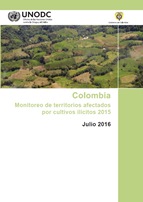Study of coca crops in Colombia recorded significant increase, going from 69,000 hectares in 2014 to 96,000 in 2015
However, in all historic series, 2015 represents one of the years with less affected area, which confirms the tendency for having more coca in less territory.
Bogota, July 8, 2016. The last Monitoring Report on Affected Territories by Illicit Crops in Colombia, elaborated by the United Nations Office on Drugs and Crime -UNODC- in collaboration with the National Government, released today, reports an increase of 39 percent, by going from 69,000 hectares in 2014 to 96,000 hectares in 2015.
In two years it has doubled exactly the territory with coca cultivation in the country. Between 2013 and 2015 it went from 48,000 hectares to 96,000 hectares.
Five departments of the 23 affected by coca crops have 81% of the planted area. They are Cauca, Nariño, Putumayo, Caquetá and Norte de Santander. This indicates that despite the high increase in the planted area, affected communities should remain the same.
This year the report also records that Caldas, Cundinamarca and La Guajira are the three departments free of coca, completing 4 years without coca cultivation. Also, that seven departments have fewer than 100 hectares of coca and move towards its consolidation as free coca crops departments, which are: Guainia, Vaupes, Arauca, Boyaca, Magdalena, Cesar and Santander.
Regarding the potential cocaine production for 2015 the estimated was 646 metric tons, an increase of 46% compared to 2014 estimates.
The publication warns that coca crops remain a threat to the biological and cultural diversity of Colombia. In indigenous reservations coca crops increased by 52 percent, going from 7,799 hectares in 2014 to 11,837 in 2015. In Lands of the Black Communities the increase was 51 percent compared to reported in 2014, by going from 10,626 hectares to 16,030.
Regarding National Parks, 58 percent of the area under coca is concentrated in Sierra de la Macarena and Nukak; the largest increases were recorded in Paramillo and Catatumbo - Bari parks, which augmented its area up to 772 hectares and 412 hectares respectively.
The Monitoring Report on Affected Territories by Illicit Crops in Colombia 2015 can be found on the websites of the Colombia Drug Observatory (http://www.odc.gov.co/) SIMCI project page (http: // www .biesimci.org /) and UNODC Colombia web page ( https://www.unodc.org/colombia).
